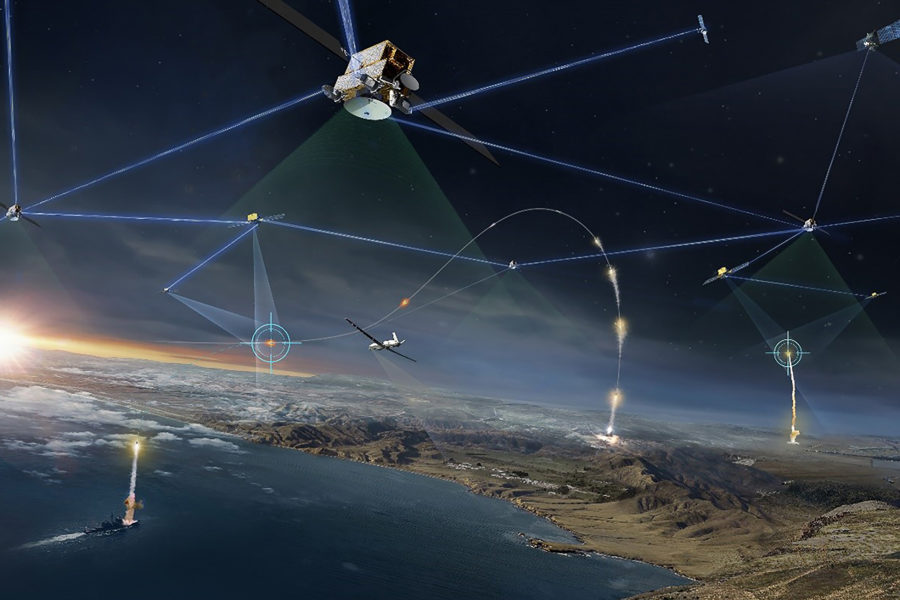The Space Development Agency plans to finish two major demonstrations of its low-Earth orbit satellites before the end of 2024—and also get started on a rapid series of launches, its director said March 6.
SDA boss Derek M. Tournear outlined the beginning stages of a quickening pace for the agency as it starts to operationalize its Proliferated Warfighter Space Architecture. Tournear made his comments during a SpaceNews webinar.
First up for SDA is establishing a “mesh network” of laser communication crosslinks connecting satellites almost like a home mesh Wi-Fi network. To more rapidly move data around the globe, the satellites were built to communicate with each other, as well as to ground stations, using laser communications. Lasers enable higher data rates and are harder to intercept.
Two missile tracking satellites built by SpaceX and launched last April have demonstrated those laser crosslinks work, Tournear said. SDA is working now with York Space Systems to demonstrate it can use the Link 16 waveform to transmit data directly from space. And in “the May timeframe, we’ll be able to have the mesh network [moving data] between the York satellites,” Tournear said. “And then we’ll work the crosslinks between York and SpaceX.”
After that come the second batch of data transport satellites—built by Lockheed Martin and launched in September 2023. They are “just completing some of their initial tests and checkout and we expect them to start their Link 16 and their optical tests probably shortly after that May timeframe,” Tournear added.
The York satellites first sent data using the Link 16 system in November, exceeding Tournear’s expectations, he said. But because of a ongoing dispute between the Pentagon and Federal Aviation Administration, Link 16 broadcasts are restricted in U.S. airspace, which meant SDA had to get a waiver from the National Telecommunications and Information Administration to allow it to transmit a Link 16 message to a Five Eyes partner nation and over international waters.
Tournear said he hoped to see the issue resolved soon.
“Primarily the FAA wants to make sure that we have compatibility features that are tested on our satellites so that we can’t interfere with any radio navigation aids,” he said. “That makes sense and we’re working with the FAA to get a plan in place to do that.”
He said he expects to be cleared to conduct “national airspace testing with our Tranche Zero satellites by the end of this calendar year.”
Proving the ability to use Link 16 is crucial because that system is so widely used and is expected to be fundamental to enabling Combined Joint All-Domain Command and Control, which will leverage SDA’s transport satellites to link sensors to shooters around the world.
Meanwhile, SDA is also pushing forward on its next batch of satellites; “Tranche 1” aims to operationalize capabilities proven in Tranche 0.
Awarded in February 2022, contracts for Tranche 1 call for satellites ready to launch by September 2024, and Tournear said he intends to stick to that schedule.
“We don’t expect to—we will launch Tranche 1 satellites in 2024,” he promised.
It will take 11 launches to complete Tranche 1—six to deploy 128 data transport satellites, four to send up 35 missile warning/tracking satellites, and one more to put a dozen demonstration and experimentation satellites into orbit.
“At least” one of those launches will come this calendar year, Tournear said, with the remainder going up at a rate of about one launch every two months. By summer 2025, there should be enough of the satellites in orbit to declare initial operational capability for the PWSA.
“I check in with my program directors daily and they check in with the vendors probably hourly,” Tournear said, explaining why he feels so confident in sharing his plans and expectations. “They have constant communications,” he said. “And every day there’s a new item that’s on the critical path and that’s the only way that we can maintain this speed of delivery, is to make sure that we stay on top of that and push forward.”
Tournear also expressed confidence he can continue to hold his cost per satellite down—just $15 million per data transport satellite, for example. Despite inflation and supply chain challenges, prices are holding steady or declining as technology gets cheaper, he said.
“As the market grows, there’ll be more volume … to be able to continue to drive those prices down,” Tournear said. “And only when we start to add new capabilities will” prices start to move in the other direction. “we essentially lose some of that price downward trend and then bring that back up by adding capabilities, he added: “That’s why we think the price should be relatively flat.”
